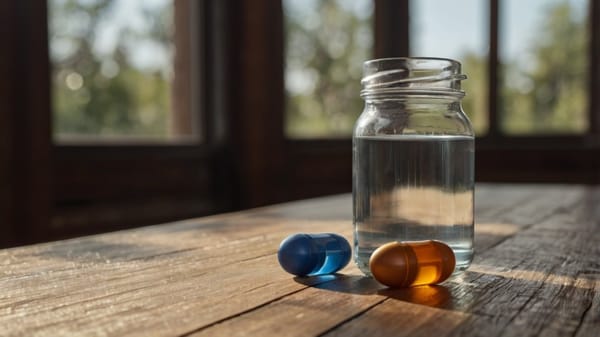The Real Reason People Swear by Vitamin D3
Vitamin D3 isn’t just for bones—it’s key to energy, focus, mood, and immunity. Here’s why most people aren’t getting enough and how to fix it.

Ever wonder why some people seem to age without slowing down—mentally sharp, energized, and steady no matter what life throws at them?
The secret might be something surprisingly simple: Vitamin D3. Your body naturally makes less of it over time, even if you're eating well or getting outside.
And when levels are low, everything from your brain to your mood and immune system can take a hit. D3 isn’t a trend—it’s the missing piece most people never realize they need.
What D3 Actually Does (It’s Way More Than Bones)
Forget everything you thought you knew about Vitamin D. This isn’t just about avoiding osteoporosis. D3 is a foundational nutrient—one your body uses like a hormone to regulate over 1,000 genes.
Here’s what that means in real life:
- It helps your brain fire cleanly, improving memory, clarity, and mood.
- It activates your immune system so you don’t get wrecked by every seasonal bug.
- It regulates inflammation, which is behind much of the fatigue, stiffness, and slowdown people often feel.
- It supports muscle strength and cellular energy, so workouts actually help instead of leave you wiped.
In short: if D3 is low, everything runs slower. Everything.

Why You’re Probably Low—Even If You Think You’re Not
Here’s what most people miss: even “normal” D levels on a lab test don’t mean optimal. The reference ranges are outdated. Doctors look for deficiency, not performance.
Plus, your body’s ability to make D3 from sunlight drops significantly over time. Even an hour outside won’t give you what you might’ve absorbed in just 15 minutes a few years ago.
Add in sunscreen, long sleeves, cloudy weather, working indoors, and you’re basically out of luck.
And food? You’d need to eat 30+ eggs or drink 10 glasses of fortified milk every single day to reach therapeutic D3 levels. Not happening. That’s why D3 supplementation isn’t just helpful—it’s essential.
The Tangible Benefits People Notice
Most people don’t realize how off they’ve been until their D3 levels rise. Then suddenly:
- They wake up earlier and actually feel rested.
- Their mood improves without changing anything else.
- Their memory gets sharper and focus lasts longer.
- They stop getting colds every month.
- Workouts feel energizing, not exhausting.
One of the most consistent reports? “I just feel like myself again.”
It’s not a jolt like caffeine. It’s a clean, sustained energy that builds each day. D3 isn’t a stimulant—it’s a switch.
The Right Way to Take Vitamin D3
Let’s get this right. You don’t need a medicine cabinet full of pills. You just need to dose smart and stay consistent.
Here’s how to do it:
- Form: Always choose Vitamin D3 (cholecalciferol). Not D2. Your body barely uses D2.
- Dose: Start with 2,000–5,000 IU daily. Most people feel best around 4,000 IU, depending on lifestyle and baseline levels.
- Timing: Take it with your largest meal, ideally one that includes healthy fats (like eggs, olive oil, avocado, salmon). D3 is fat-soluble—this boosts absorption.
- Consistency: Skip a day and your body drops right back down. Think of D3 like brushing your teeth—daily habits = lasting results.
Bonus tip:
Take it in the morning or midday, not at night. D3 supports your body’s natural circadian rhythm. Taking it too late can mess with sleep instead of helping it.
The D3 + K2 Combo: Why It Matters
You’ve probably seen D3 sold with Vitamin K2. That’s not a marketing trick—it’s smart biology.
Here’s why K2 matters: D3 helps your body absorb calcium. But K2 helps direct it where it belongs (your bones) and keeps it away from places it doesn’t belong (your arteries).
So if you’re going high on D3, make sure K2 is in the mix. Either in the same capsule or as a separate supplement.
Want Faster Results? Stack It Like This
If you really want to feel the full effect, D3 works best when combined with a few strategic allies:
1. Magnesium
You need it to activate Vitamin D. Without it, D3 can’t do its job. Take 200–400mg of magnesium glycinate or citrate, preferably at night.
2. Omega-3s (Fish Oil or Algae Oil)
Supports brain health, reduces inflammation, and complements D3’s immune benefits. Shoot for 1,000–2,000mg daily with a meal.
3. Sunlight Exposure
Even short bursts of morning sun (10–20 mins) help sync your body’s natural D3 rhythms. Think of it as a bonus layer, not a replacement.
This trio—D3 + Magnesium + Omega-3s—is one of the cleanest, easiest stacks to upgrade your health without overcomplicating things.
What to Expect (And When)
Most people feel a difference in the first 7–10 days. Energy is usually the first thing to shift—especially in the morning.
By week 3, mood and focus tend to improve. Work feels less like a slog. Tasks feel lighter. You might even find yourself sleeping deeper and waking up before your alarm.
After 30 days, people notice a clear “before and after” moment. It’s like background noise in your body fades, and you finally get your momentum back.
Stick with it. D3 is a compound interest supplement. The longer you stay consistent, the stronger the returns.
Final Thoughts: Turn the Lights Back On
You don’t need more caffeine. You don’t need another app. You need to give your body something it’s been missing for years—and once you do, everything starts working like it should.
Vitamin D3 isn’t a trend. It’s a fundamental reset button for energy, clarity, mood, and immunity. The longer you wait, the longer you keep running at half power.
Start today. One capsule. Every morning. Feel better in a week. Feel different in a month. You’ve got nothing to lose—and your old self to gain.




